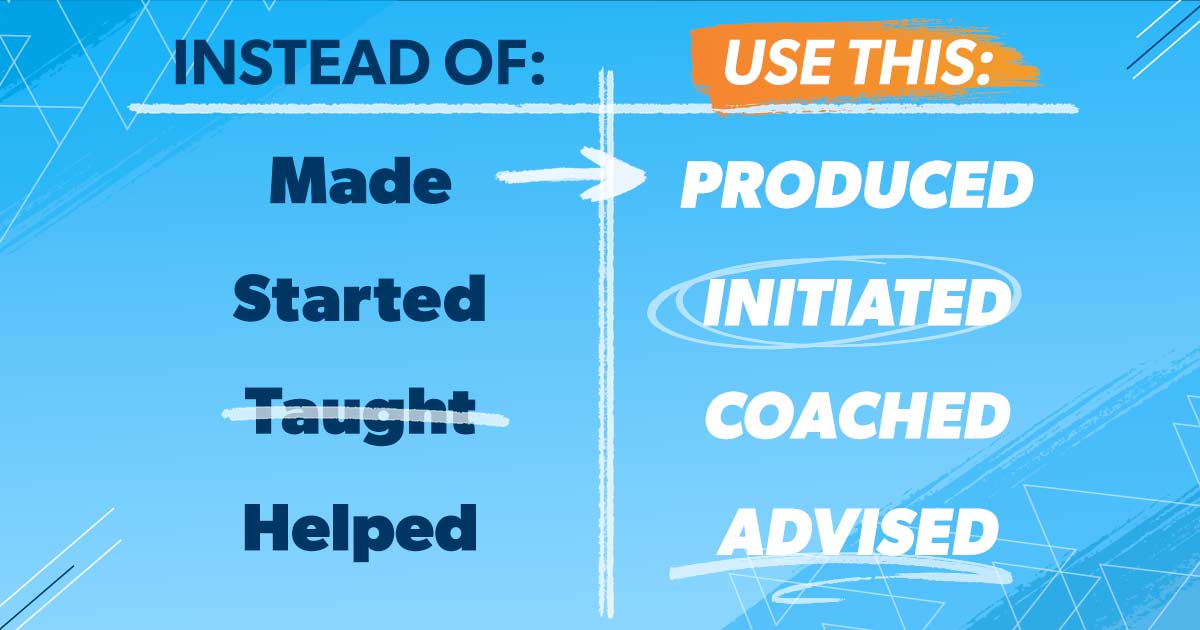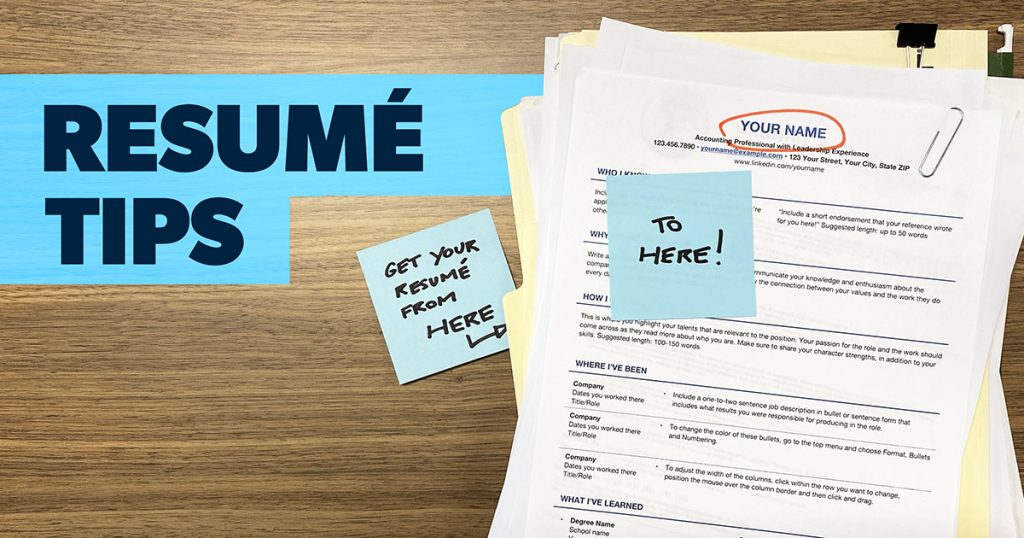Believe it or not, creating a solid resumé is just as important as prepping for and nailing your job interview. After all, your resumé is your chance to make a strong first impression on the recruiter! But before you get too freaked out, know this: Building the perfect resumé is actually a lot simpler than it sounds. And once you’ve read these 16 tips, you’ll be ready to move forward into the job search with confidence.
1. Keep it one page.
Do you know how much time a recruiter spends looking at your resumé on the first go-around? About 7.4 seconds.1 Whoa. So, if they have to flip or scroll through pages of your accomplishments and past experience, this party could be over before it even starts. Keeping things simple, relevant and to the point will earn you some respect right off the bat. If things go well here, you’ll have the opportunity to answer the most common interview questions in person!
2. Link to online portfolios.
Some job applications may ask you to send samples of your work, but even if they don’t, there’s still a classy way to show off what you do best. Try including a link to an online portfolio or professional website if you have one—that way you’ll be able to showcase more of your work without taking up space on your actual resumé.
3. Make sure your contact info is professional.
Nobody wants to send an email to sk8rboi2002. Don’t use your college email address either. Just a normal, boring email account with your first and last name will get the job done. And don’t forget to include your phone number (but make sure your voicemail greeting isn’t anything funny or clever).
4. Include relevant social media accounts.
I know I’m talking to adults here, but I just have to say it: Double-check all your social media accounts to make sure they’re recruiter-friendly, especially if you include any of your social media handles on your resumé. But even those should only be on your resumé if they’re relevant to the position you’re applying for. For most jobs, your LinkedIn account is the only one you need to include.
5. Skip the bio.
It used to be trendy to put a paragraph about yourself at the top of your resumé, but let that trend die—especially if you’re also submitting a cover letter with your application. You don’t need to put an elevator pitch or your life story under your name at the top of your resumé. Remember, we’re keeping this relevant and to the point!
6. Evaluate whether you need a photo.
When it comes to photos, be strategic about whether or not you put your picture on your resumé. It could make sense to include one if you’re applying for a modeling or acting job, but accounting? Yeah, they probably don’t care what you look like or if your resumé is fun.
And even though recruiters aim to stay as unbiased as possible during the interview process, a less-than-great-quality photo could subconsciously affect their impression of you, even if they don’t mean for it to. So, if you do decide to go with the photo option, make sure it’s not pixelated, blurry or too small to see.
7. Keep the job listing in mind.
Recruiters post job descriptions for a reason—they want to be clear and specific about what qualities and skills they’re looking for. Look for those buzzwords and find ways to work them into your resumé (doing that will help you beat the applicant tracking system). Be honest about your skill set and don’t get discouraged if you don’t have every skill on the list. It could actually be a good thing to be slightly underqualified. You want to be challenged in your new role! And many employers are willing to work with you and train you when you first step into the job—as long as you have a growth mindset.
8. Tweak your resumé for each role.
I know it might sound like a lot of work to tailor your resumé to each job application, but that effort will really pay off. Recruiters will know that you took the time to read all the info and are seriously interested in their company, not just sending a cookie-cutter application to hundreds of different jobs.
9. Tell the truth.
Okay, this one is a no-brainer application and interview tip in general, but enough people have lied or “stretched the truth” on their job applications to make it worth mentioning. Don’t say you know someone at the company if you’ve never talked to them before. Don’t say you know how to use Excel and PowerPoint if you really don’t. It’ll just make you look shady when the recruiter asks you for more specifics (or worse, if you do get hired, and then they have to show you how to make a spreadsheet).
10. Make it easy to read.
When building your resumé, put yourself in the recruiter’s position. What would you be looking for? You’d probably want something that’s clear and easy on the eyes, right? Here are some things that can help with that:
- Use 10- to 12-point font.
- Use a professional font, like Helvetica, Arial, Calibri, Times New Roman, etc. (no Comic Sans unless you’re going for the community-center-bulletin-board look).
- Keep your headers simple and use concise bullet points below them.
- Don’t use too many variations in font size, color and style (bold, italics or underline).
Sure, there’s room for some creativity, but nothing too crazy—think streamlined and classic. Recruiters will love you for it, because you’ll make their job easier! For extra help with formatting, check out my free Resumé Guide.
11. Use active words.
Recruiters are used to seeing words like managed or led on resumés, and there’s nothing wrong with those words. But what if the language was just a little more engaging? Here are a few active, interesting and not-too-fancy words to use where it makes sense:
- Produced
- Executed
- Engineered
- Initiated
- Developed
- Coordinated
- Simplified
- Partnered
- Coached
- Advised
- Delivered
- Maximized
You get the picture. Again, you want to make sure the words you use to describe what you did are truthful, but spend some time with a thesaurus to see if there’s a more descriptive way to say it.
You deserve to win at work. Our new book and assessment will show you how.

12. Explain why you’re a good fit.
Remember when we talked about tailoring your resumé to each job you’re applying for? Your resumé should include a few words about why you want to work for this company. It’s one thing to know that someone wants to work for you, but if you see that they genuinely care about the company and its mission, wouldn’t you be way more likely to want them on your team? I know I would.
13. Give concrete examples.
When talking about your past experience, it’s a good idea to quantify it by using some kind of number or measure of success. That will give recruiters a clear picture of the kinds of results you deliver! Here are a few examples:
- Increased sales by 200% in one year.
- Structured, wrote and posted four to five articles per week.
- Served 20 to 30 clients per week and generated $10,000 in revenue per month.
Even if your past experience wasn’t in sales or you don’t know how much revenue you brought in, you can find some way to explain the work you did in terms of numbers.
14. Proofread your resumé.
Spelling and grammar are your friends! Even just one case of using the wrong their can sway a recruiter’s opinion, so read over everything more than once. Proofreading is like making sure you don’t have a mustard stain on your interview outfit before you walk inside!
Ask a few other people you trust to give you some feedback too—not just on the tiny details, but on the clarity and appearance of your resumé as a whole.
15. Put your education last.
Ken, are you crazy? Education is the first thing you’re supposed to put on your resumé. Wrong! Always put the most important and relevant information first—and in most cases, that’s who you know at the company and why you want to be there, not your education. Most recruiters don’t care where you went to school, as long as you’re educated in your field.
And don’t forget to include any other training or educational courses that are relevant to the job you want (especially if you don’t have lots of work experience)!
16. Don’t be afraid to use a template.
There’s no shame in using a template to help you build your resumé—in fact, it will make your life a whole lot easier. I’ve included six different templates in my Ken Coleman Resumé Templates that will help you get your resumé where it needs to be in no time.
These templates are something my team and I put together to give you more in-depth tips on creating the perfect resumé. You’ll also get instructions for using the templates, plus a list of do’s and don’ts when it comes to applying for jobs. I hope this helps you through the job search process. Happy resumé building!
Read the full article here











